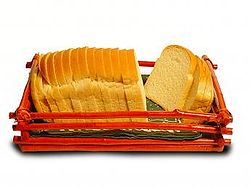Slice of bread

A loaf of white bread sliced to uniform thickness by a bread slicing machine
|
|
| Type | Bread |
|---|---|
| |
|
Sliced bread is a loaf of bread that has been sliced with a machine and packaged for convenience. It was first sold in 1928, advertised as "the greatest forward step in the baking industry since bread was wrapped". This led to the popular phrase "".
Otto Frederick Rohwedder of Davenport, Iowa, United States, invented the first loaf-at-a-time bread-slicing machine. A prototype he built in 1912 was destroyed in a fire and it was not until 1928 that Rohwedder had a fully working machine ready. The first commercial use of the machine was by the Chillicothe Baking Company of Chillicothe, Missouri, which produced their first slices on July 7, 1928. Their product, "Kleen Maid Sliced Bread", proved a success. Battle Creek, Michigan, has a competing claim as the first city to sell bread sliced by Rohwedder's machine; however, historians have produced no documentation backing up Battle Creek's claim. The bread was advertised as "the greatest forward step in the baking industry since bread was wrapped."
St. Louis baker Gustav Papendick bought Rohwedder's second bread slicer and set out to improve it by devising a way to keep the slices together at least long enough to allow the loaves to be wrapped. After failures trying rubber bands and metal pins, he settled on placing the slices into a cardboard tray. The tray aligned the slices, allowing mechanized wrapping machines to function.
W.E. Long, who promoted the Holsum Bread brand, used by various independent bakers around the country, pioneered and promoted the packaging of sliced bread beginning in 1928. In 1930 Wonder Bread, first sold in 1925, started marketing sliced bread nationwide.
As commercially sliced bread resulted in uniform and somewhat thinner slices, people ate more slices of bread at a time, and ate bread more frequently, because of the ease of eating another piece of bread. This increased consumption of bread and, in turn, increased consumption of spreads, such as jam, to put on the bread.
During 1943, U.S. officials imposed a short-lived ban on sliced bread as a wartime conservation measure. The ban was ordered by Claude R. Wickard who held the position of Food Administrator, and took effect on January 18, 1943. According to the New York Times, officials explained that "the ready-sliced loaf must have a heavier wrapping than an unsliced one if it is not to dry out." It was also intended to counteract a rise in the price of bread, caused by the Office of Price Administration's authorization of a ten percent increase in flour prices.
...
Wikipedia
